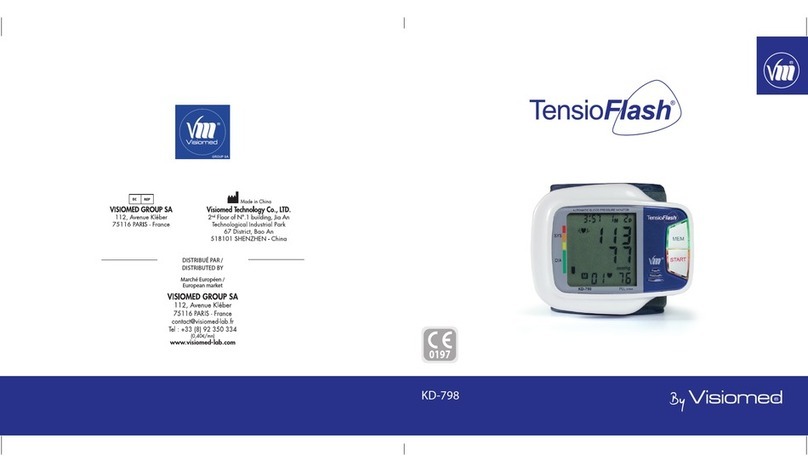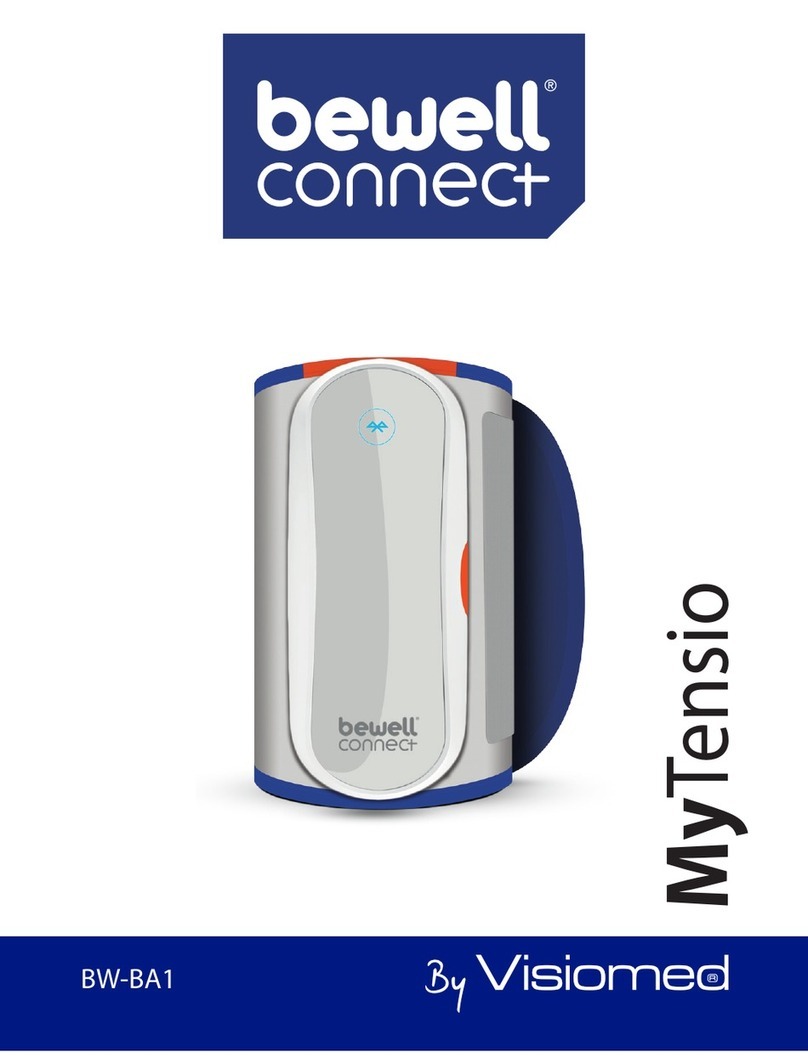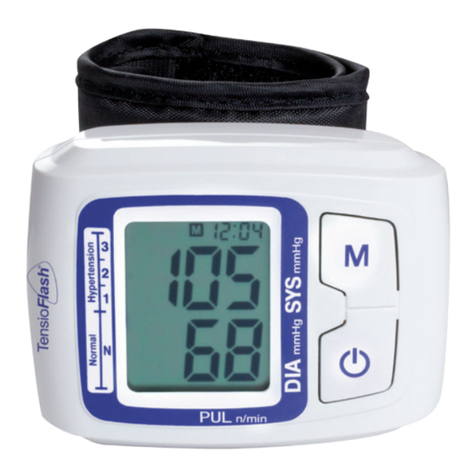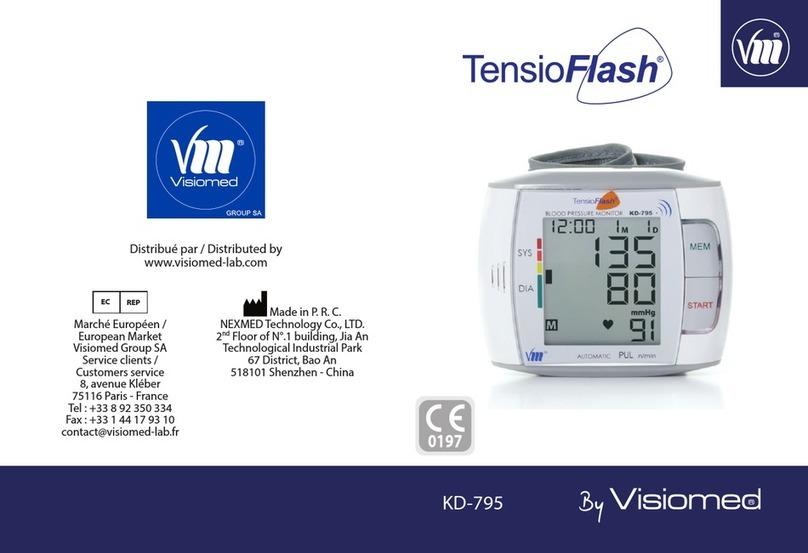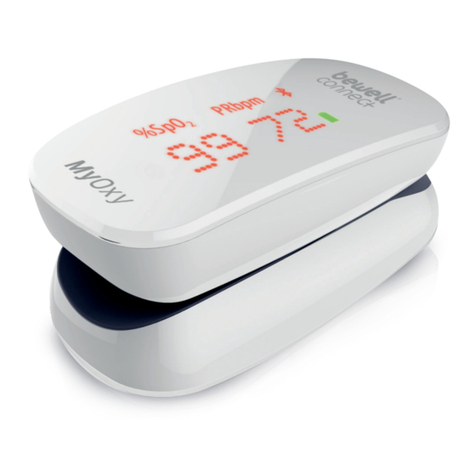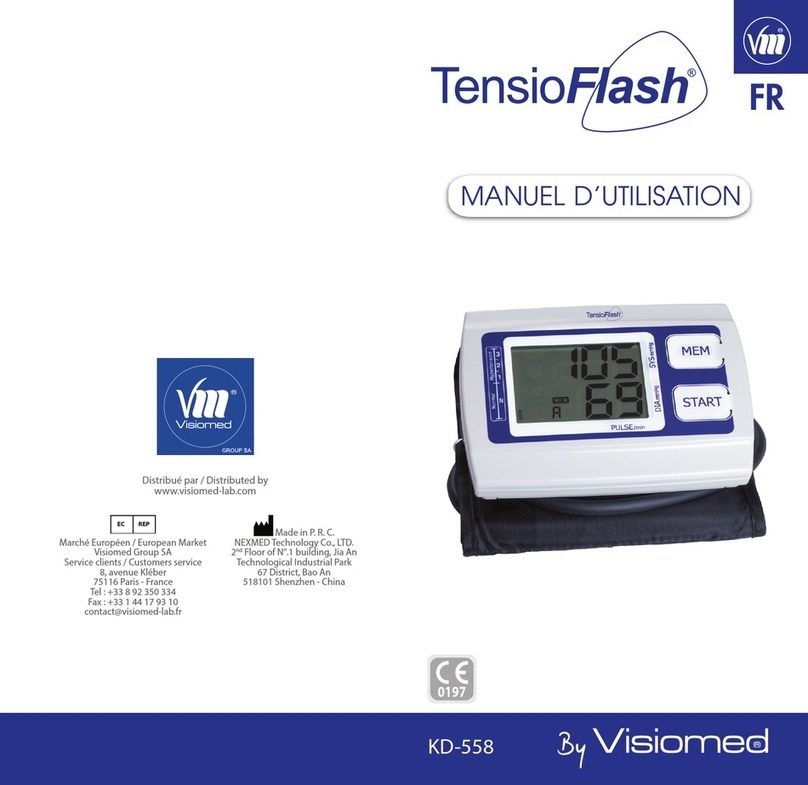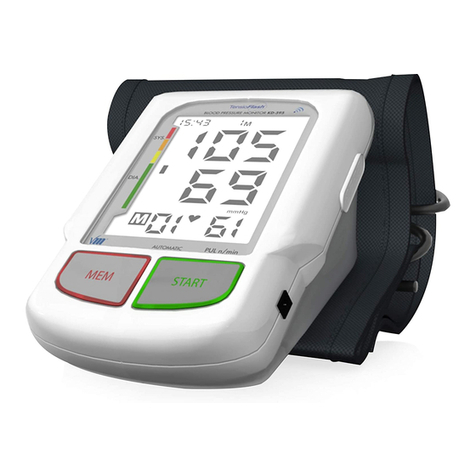
Visiomed - KD-595 - Manuel d’utilisation - 072017
4 5
Visiomed - KD-595 - Manuel d’utilisation - 072017
Dispositif médical conforme aux normes européennes en vigueur.
A lire impérativement avant utilisation.
TABLE DES MATIÈRES
Le fabricant se réserve le droit de modifier sans aucun avis préalable les
caractéristiques techniques du produit
Cher Client,
Vous venez d’acquérir cet autotensiomètre VISIOMED et nous vous en remercions. Nous vous en souhaitons un excellent usage
et vous recommandons de lire attentivement cette notice d’utilisation afin de procéder en toute efficacité à la mesure de votre
tension artérielle.
1. AVERTISSEMENT
- Suivre les instructions d’entretien stipulées dans cette notice.
- Cet appareil peut être utilisé pour un usage personnel à domicile.
- Utiliser cet appareil uniquement pour l’usage auquel il est destiné tel que décrit dans cette notice.
- Utiliser cet appareil dans une plage de température ambiante comprise entre 5 à 40°C.
- Cet appareil doit toujours être placé dans un endroit propre et sec.
- Ne pas exposer cet appareil aux chocs électriques.
- Ne pas exposer cet appareil à des conditions de températures extrêmes T°>55°C - T°< - 20°C.
- Ne pas exposer cet appareil au soleil, ni à l’eau.
- Ne pas utiliser cet appareil en extérieur.
- Ne jamais laisser tomber l’appareil.
- Ne pas assurer vous-même l’entretien de cet appareil. Ne pas essayer d’ouvrir l’appareil. En cas de problème, contactez votre
revendeur.
- Cet appareil n’est pas prévu pour être utilisé par des personnes (y compris les enfants) dont les capacités physiques, sensorielles
ou mentales sont réduites, ou des personnes dénuées d’expérience ou de connaissance, sauf si elles ont pu bénéficier par
l’intermédiaire d’une personne responsable de leur sécurité, d’une surveillance ou d’instructions préalables concernant
l’utilisation de cet appareil.
- Ce matériel médical électrique nécessite des précautions spécifiques concernant la compatibilité électromagnétique. Il doit être
installé et mis en service conformément aux informations électromagnétiques fournies dans le tableau EMC Data.
- Les mesures peuvent être altérées en cas d’utilisation près d’un téléviseur, d’un four à micro-ondes, d’un téléphone portable ou
tout autre appareil à champ électrique.
- Les résultats de mesure sont donnés à titre indicatif. En cas de doute concernant vos résultats, veuillez contacter votre médecin.
- Cet appareil ne doit pas inciter à l’automédication ou à l’adaptation de votre traitement.
- Cessez d’utiliser l’appareil en cas d’anomalie ou de dysfonctionnement.
- Ne gonfler la brassière qu’autour du bras.
- Ne pas tirer sur le tube à air, utiliser l’embout plastique pour retirer le brassard.
-N’utiliser que les accessoires et pièces détachées spécifiés par le fabricant ou vendus avec l’appareil.
2. LA PRESSION ARTERIELLE
La pression artérielle varie considérablement au cours de la journée et ces variations sont encore plus significatives chez les
sujets hypertendus. Elle est plus basse le matin et augmente l’après-midi puis le soir. Durant le sommeil, elle diminue. La pression
artérielle est plus basse en été qu’en hiver et s’élève sensiblement avec l’âge. La pression artérielle augmente aussi pendant
l’effort, les rapports sexuels, la grossesse, le stress...
1. AVERTISSEMENT...................................................................................................................................................................... 5
2. LA PRESSION ARTERIELLE ...................................................................................................................................................... 5
3. PRÉCAUTION AVANT UTILISATION....................................................................................................................................... 7
4. CARACTÉRISTIQUES DU TENSIOFLASH® KD595................................................................................................................. 7
5. UNITÉ PRINCIPALE................................................................................................................................................................... 7
6. CHANGEMENT DES PILES........................................................................................................................................................ 7
7. PARAMÈTRAGE DE LA DATE ET DE L’HEURE ........................................................................................................................ 8
8. MODE VOCAL ........................................................................................................................................................................... 8
9. CONNEXION DU BRASSARD À L’APPAREIL........................................................................................................................... 8
10. SUGGESTIONS AVANT MESURE........................................................................................................................................... 8
11. UTILISATION DE LA BRASSIÈRE ........................................................................................................................................... 9
12. POSITION DU CORPS PENDANT LA MESURE ..................................................................................................................... 9
13. MESURE DE LA TENSION ARTÉRIELLE................................................................................................................................. 9
14. MÉMORISATION DES DONNÉES........................................................................................................................................... 10
15. ENTRETIEN DE L’APPAREIL................................................................................................................................................... 11
16. ÉVITER LES DYSFONCTIONNEMENTS ................................................................................................................................. 11
17. SPÉCIFICATIONS TECHNIQUES ............................................................................................................................................ 11
18. GUIDE DE DÉPANNAGE......................................................................................................................................................... 12
